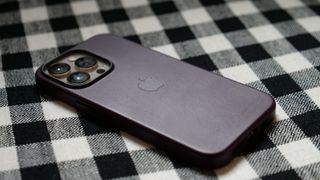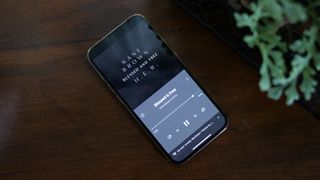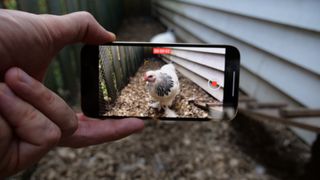OnePlus 10 Pro vs. iPhone 13 Pro: Which phone is best?
Is the OnePlus 10 Pro a challenger or pretender to the throne?

After months of waiting, the OnePlus 10 Pro global launch event finally happened. We were lucky enough to spend a couple of weeks with the phone ahead of the launch, so we’re ready to pit it against some of the other top flagships on the market and why not start at the top with the iPhone 13 Pro.
OnePlus broke from its flagship killer roots last year and was just a few Hamiltons away from the $999 price point of the Pro iPhone models, but the young, scrappy and hungry manufacturer appears to have rethought that plan and dropped back to a more affordable $899 starting price for the OnePlus 10 Pro. While it is spruced up with a new design and retains flagship specs like the Snapdragon 8 Gen 1 processor, an adaptive 120Hz display, and a 5,000mAh battery, that price drop had to come from somewhere, and a couple of features took a step back.
So the question is whether OnePlus made the right choices and if it remains close enough to the iPhone that the discount is worth those tradeoffs. Read on for my in-depth comparison of the OnePlus 10 Pro vs. the iPhone 13 Pro.
- Best smartphones in 2022
- Best budget phones in 2022
- Best mobile phone deals available today
OnePlus 10 Pro vs. iPhone 13 Pro: price and value
The OnePlus 10 Pro starts at $899 for the 128GB model with 8GB of RAM. That is the only model available at launch, but OnePlus stated a second model will be available later with 256GB of storage and 12GB of RAM.
The iPhone 13 Pro starts at $999 for a 128GB model with 6GB of RAM. You can upgrade to 256GB, 512GB, or a new 1TB option. It’s an extra $100 for the 256GB model, which is necessary for the new ProRes video feature on iPhone 13 Pro. Add another $200 for the 512GB and 1TB options, which max the phone out at $1,499.

The OnePlus 10 Pro got a $70 price drop from its predecessor and matches up with one of our favorite affordable flagship phones, the Pixel 6 Pro. The $100 advantage over the iPhone is enough to sway some purchasing decisions. Now, if you like to take a lot of photos and videos, there are a couple of things to consider here as you should upgrade to the 256GB 13 Pro, taking you to $1,099. Unfortunately, you have no option to do this with OnePlus right now, so you’ll need to factor in the cost of a cloud storage solution or plan to offload your photos and videos to your laptop.
Despite the price advantage for the OnePlus 10 Pro, I have to call this a draw due to the iPhone’s considerable camera advantage and the roughly six years of software support compared to four years of security updates and three years of major OS updates for the OnePlus 10 Pro.
Stay in the know with Laptop Mag
Get our in-depth reviews, helpful tips, great deals, and the biggest news stories delivered to your inbox.
Winner: Draw

OnePlus 10 Pro vs. iPhone 13 Pro: design
While Apple’s iPhone SE 2022 isn’t getting a lot of love for its throwback look, the iPhone 13 Pro represents a fantastic modern reimagining of the iconic iPhone 4 design. It’s a comfortable build that is also instantly recognizable. The OnePlus 10 Pro design won’t muster quite the same reverence, but the matte frosted glass finish looks and feels fantastic, and its new camera finally gives the OnePlus a unique look to call its own.
There will be opinions on both sides from a purely aesthetic standpoint, but I don’t think there’s an obvious winner. The OnePlus unquestionably differentiates itself less from other flagships, but while originality is appreciated, it isn’t everything. Looking at the designs, both offer a premium feel and while the 13 Pro with its 6.1-inch display is far more pocketable than the OnePlus with its 6.7-inch display. However, each one is comfortable to hold and use one-handed.
I prefer the camera array of the OnePlus 10 Pro. Thanks to its seamless integration into the frame of the phone and its less pronounced lenses, it is easier to slip in and out of my pocket and sits nicely on a flat surface. If you always use a case with your phone, these are less meaningful distinctions, but the OnePlus 10 Pro is one of the nicest phones to use caseless that I’ve reviewed in years.

Durability tips heavily in favor of the iPhone 13 Pro. Not only does it offer Apple’s proprietary Ceramic Shield covering on the display, but Apple boasts the best IP68 certification on any traditional smartphone. OnePlus uses the solid Gorilla Glass Victus covering on the display, just a step down from the Victus+ on the Galaxy S22 series, but it lacks any IP certification. Now it’s unclear whether the phone actually isn’t waterproof or if OnePlus simply hasn’t sought certification, but it certainly should make you less comfortable risking your phone taking a deep or a heavy downpour.
As I already mentioned, the OnePlus 10 Pro is considerably larger at 6.4 x 2.9 x 0.33 inches compared to 5.8 x 2.8 x 0.3 inches for the iPhone 13 Pro. However, the 10 Pro weighs 0.1 ounces less than the 7.2-ounce iPhone. This is attributable to Apple’s more robust materials and likely the larger camera array.
While it’s close, durability is the deciding factor for me in this category, an IP68 rating is expected at this price point and whether the OnePlus 10 Pro can withstand a little water or not, it’s clear OnePlus isn’t going to stand behind that.
Winner: iPhone 13 Pro

OnePlus 10 Pro vs. iPhone 13 Pro: display
The OnePlus 10 Pro features a 6.7-inch, QHD+ (3216x1440 pixel) LTPO AMOLED display with an adaptive 120Hz refresh rate. The iPhone 13 Pro has a much smaller 6.1-inch Super Retina XDR (2532x1170 pixel) display with ProMotion, which also offers an adaptive 120Hz refresh rate.
Despite the much larger display, the OnePlus 10 Pro is also sharper at 525 pixels per inch (PPI) compared to 460 PPI for the iPhone 13 Pro. You would need to be a serious pixel peeper to worry about that distinction, but it’s an edge for the 10 Pro regardless.
If your phone is your primary content consumption device or you simply like a big screen, the OnePlus 10 Pro obviously has a quite literally massive advantage. You would need to bump up to the iPhone 13 Pro Max for screen size parity, but starting at $1,099 for the 128GB model, you are now $200 north of the 10 Pro.
Both phones feature adaptive 120Hz refresh rates, which is excellent as it means you get to enjoy the smooth animations and high frame rate content without suffering from the battery drain of a constant 120Hz. Both platforms still have a way to go when it comes to developer support for 120Hz, but the tide is now turning with most flagships featuring a high refresh rate and it’s a great experience already in the core OS and the hundreds of apps and games that do support it.

I turned to the “Birds of Prey” episode of the Animals documentary series on Netflix for a test of the HDR performance on each phone. The iPhone 13 Pro is undeniably brighter, but as I’ve noted in the past, it has a warm cast to the display that I wish I could adjust. The OnePlus 10 Pro has more depth of color to it, but side-by-side, except for that color discrepancy, the iPhone 13 Pro image looks better to my eye.
Letting our lab tests weigh in on the matter, in our colorimeter results, the OnePlus 10 Pro covers 84.3% of the DCI-P3 color gamut in its Natural color setting. The iPhone 13 Pro comes close at 82.5%. However, the 10 Pro has the ace up its sleeve that most Android phones offer with the ability to boost to Vivid mode, and in that setting, it reaches 123%.
My eyes did not deceive me when it came to brightness; the iPhone 13 Pro delivered 1,024 nits of brightness, almost 40% brighter than the OnePlus 10 Pro’s 738 nits. Either one holds up fine in sunlight, but the iPhone outshines the OnePlus.
If the display size carries significant weight for you, this easily tips in favor of the OnePlus 10 Pro, but watching content on the phones side-by-side, I found that I preferred the iPhone 13 Pro image.
Winner: iPhone 13 Pro

OnePlus 10 Pro vs. iPhone 13 Pro: performance
I feel a little bad for the Android phones when I get to this section of the face-off; it’s like a star high school runner that accidentally finds themselves lined up on the track at the Olympics. However good they might be, the iPhone and its A15 Bionic processor are just in a different class.
The Qualcomm Snapdragon 8 Gen 1 powering the OnePlus 10 Pro is an excellent SoC that delivers all of the performance that you will need from your phone. We loaded up dozens of Google Chrome tabs, apps, picture-in-picture videos, and games in our review of each phone, and neither skipped a frame. Max out the settings on whatever 120Hz game you love the most and both phones will churn through them and deliver the kind of buttery smooth performance reserved for the best gaming laptops a few years ago.
As we turn to our benchmark and some specific real-world tests, the iPhone 13 Pro has an opportunity to flex its muscles. On the Geekbench 5 overall performance test, the iPhone 13 Pro holds the new mobile record at 4,718. The OnePlus 10 Pro managed a respectable 3,482, but with a 35% higher score, it’s a pretty open and shut case for the iPhone. Our graphics-focused testing wasn’t as bleak, with the OnePlus 10 Pro hitting 61 frames per second on 3DMark Wild Life Unlimited, giving the iPhone 13 Pro a mere 15% advantage with its 70 fps.

The Adobe Premiere Rush video editing test is a real-world example of Apple’s SoC dominance; the iPhone 13 Pro finished rendering and exporting a 4K video to 1080p in just 26 seconds. The same task took the OnePlus 10 Pro one minute and two seconds. Now it’s perhaps worth considering whether you export a lot of video or comparable tasks on your phone, but there’s no denying the iPhone is faster at any task you can give it.
Don’t worry that the OnePlus 10 Pro will disappoint you with slow performance, but the iPhone 13 Pro is faster now and will almost certainly still be faster than the OnePlus 11 Pro when it launches next year and perhaps the OnePlus 12 Pro in 2024. That’s just how far ahead Apple is right now.
Winner: iPhone 13 Pro

OnePlus 10 Pro vs. iPhone 13 Pro: battery life and charging
After that crushing defeat, the OnePlus 10 Pro can use this one; with a 5,000mAh battery, you would assume it should easily outlast the 3,095 mAh battery found in the iPhone 13 Pro. While Apple has some dark magic that allows it to squeeze an improbable amount of battery life out of those cells, OnePlus has some tricks of its own.
In my reviews of both phones, I was pleased with the battery life and never had an issue with either one dying before the end of the day. Typically, I would end with around 25% remaining, so the end result is virtually identical despite the hardware disparity.
Of course, real-world testing is fraught with peril as no two days are truly identical; fortunately, our Laptop Mag battery life test has each phone surf the web on a cellular connection at 150 nits. The iPhone 13 Pro died at 12 hours flat, while the OnePlus 10 Pro came up just minutes shy at 11 hours and 56 minutes. These are outstanding results for both phones and landed them among our phones with the best battery life.

So battery life won’t settle this category; let’s look at charging. Apple’s 20W charger, which you need to purchase separately, gets the iPhone 13 Pro to 25% in 15 minutes and 53% in 30 minutes. The OnePlus 10 Pro, on the other hand, includes its 65W charger in the box that takes the phone to 55% in 15 minutes and 93% in 30 minutes.
Both phones also support wireless charging with Qi compatibility, and the iPhone 13 Pro offers Apple’s proprietary MagSafe charging. We are finally seeing more MagSafe accessories, but the OnePlus 10 Pro supports 50W wireless charging if you purchase the OnePlus Plus Warp Charge 50 stand.
Battery life is a wash, but with more than double the charging speed of the iPhone 13 Pro, the OnePlus 10 Pro takes this category.
Winner: OnePlus 10 Pro

OnePlus 10 Pro vs. iPhone 13 Pro: cameras
OnePlus entered a multi-year partnership with Hasselblad to improve its cameras last year and it has paid dividends with a marked improvement to the color science, computational photography and camera app in general on the OnePlus 9 series and now OnePlus 10 Pro. However, either due to design or cost, the company hasn’t invested in superior camera hardware this year and it shows.
The OnePlus 10 Pro features the same exclusive Sony IMX789 48MP wide-angle sensor at f/1.8 as the 9 Pro. The new 50MP at f/2.2 ultra-wide offers some interesting capabilities with a 150-degree field of view, but it is a smaller sensor than last year which shows in low-light performance. The 8MP 3.3x telephoto at f/2.4 is also a holdover from last year, while the front-facing camera alone gets a clear upgrade with a 32MP Sony IMX615 with a 27% wider field of view.
If you were to go by megapixels alone, this would sound like an easy win for OnePlus over the 13 Pro’s trio of 12MP rear cameras, but if I haven’t dissuaded you from that notion already, let me do so now. The primary sensor on the iPhone 13 Pro now features an incredible f/1.5 aperture and larger 1.9um pixels; for practical purposes, this means it will dramatically outperform the OnePlus in low light. The same can be said of the 12MP ultra-wide on the 13 Pro, which leaped to f/1.8, matching the primary on most other flagship phones. The 3x telephoto on the 13 Pro is the only push at f/2.4, but it has a slightly higher 12MP output. The front-facing camera is again 12MP, but it benefits from Apple’s excellent True Depth sensor for selfies.

The primary cameras from both phones are solid in daylight; the iPhone’s hardware advantages don’t really come into play there, so it’s a pure camera software fight. As I said, the Hasselblad partnership has paid off for OnePlus in this regard as I love the colors and it added a new Master Styles mode this year that like the Photographic Styles on the iPhone tweaks the image with instant post-processing that can punch up your photos. Where they break apart is low-light, in challenging lighting conditions like the fountain shot below, the iPhone 13 Pro is retaining details in the sculpted figures that the OnePlus can’t hope to match and won’t give way to a blurry mess as easily because of that larger sensor and aperture.
Ultra-wide is more of the same, the daylight shots look very similar between the two with the iPhone looking a bit more natural to my eye. But again, you can use those Photographic Styles to tweak that if you want a more vivid look. However, low-light is an even bigger miss for the OnePlus ultra-wide as it moved to a smaller sensor than last year and is an f/2.2 versus the f/1.8 of the iPhone. I will note that there is a lot of fun to be had with the 150-degree field of view on the OnePlus 10 Pro and its fisheye mode; it allows you to capture an entire scene that would require a stitched panorama from the 13 Pro.

OnePlus 10 Pro ultra-wide

OnePlus 10 Pro ultra-wide

OnePlus 10 Pro ultra-wide

OnePlus 10 Pro ultra-wide

iPhone 13 Pro ultra-wide

iPhone 13 Pro ultra-wide

iPhone 13 Pro ultra-wide
Telephoto shots are where things fall apart for OnePlus. The 3.3x optical zoom delivers solid detail, but disintegrates with any digital zoom applied due to that 8MP resolution. Unlike the former lenses, the color and exposure are often missed with this lens as you can see in the photo of the queen's guard statue. The iPhone 13 Pro remains consistent and while it features a slightly weaker 3x optical zoom, the extra resolution and its sensor-shift image stabilization allow it to extend a bit further with its digital zoom.
Whether it’s selfies or portraits from the rear-facing cameras, the iPhone 13 Pro wins. The true-depth sensor on the front and LiDAR sensor on the back give it better depth data and as you can see in the selfie below it produces a much sharper edge before following off into the blurry bokeh.
Whether it’s selfies or portraits from the rear-facing cameras, the iPhone 13 Pro wins. The true-depth sensor on the front and LiDAR sensor on the back give it better depth data and as you can see in the selfie below it produces a much sharper edge before following off into the blurry bokeh.

Apple remains the gold standard when it comes to mobile video. While I don’t personally find Cinematic Video that compelling, there’s no arguing that the sensor-shift stabilization and excellent audio features all yield a better package. The OnePlus 10 Pro isn’t a slouch in the video department; it can capture 8K video at up to 24 frames per second and 4K at up to 120fps for some buttery slow-motion playback. You can even capture footage in a LOG format to apply a picture profile and color grade your videos.
The OnePlus 10 Pro is not a terrible camera phone, but it is simply outmatched in this contest.
Winner: iPhone 13 Pro

OnePlus 10 Pro vs. iPhone 13 Pro: software
While our own Kimberly Gedeon recently asked three phone experts for their Android or iPhone preference, that’s not really what I’m looking at here; iOS and Android are both mature operating systems that will allow you to get just about anything done on mobile.
iOS 15 introduced brought some useful new additions to the iPhone, including new granular notification controls, enhancements to Apple Maps, and a more robust Photos app to compete with Google Photos. In a rare move, it even improved the ability to interact with non-iPhone users by adding FaceTime support for Windows and Android users. One of Apple’s biggest advantages remains the smooth interaction between its entire ecosystem of products, so if you already have an Apple Watch, an iPad or a MacBook, there’s a strong incentive to go with the iPhone as well.

OnePlus runs OxygenOS 12.1, a modified version of Android 12. OxygenOS 12.1 looks more like Samsung’s One UI than the Pixel version of Android. It adds unique features like OnePlus Shelf, an easily glanceable collection of widgets for access to some of your most-used tools with a swipe down from the top-right corner of the screen. Work Life Balance 2.0 from OnePlus is akin to Focus modes on macOS and iOS, allowing you to reduce distractions from either your work or home life depending on whether you are or what time it is. Finally, for those with privacy concerns, a new Private Safe can store videos, photos, documents, or any digital data you want behind a password or fingerprint encryption that is inaccessible by any other apps.
Android manufacturers are getting better about software support, with OnePlus committing to four years of security updates and three major OS updates. However, this still pales in comparison to the roughly six years of updates iPhone users enjoy. Now, if you swap phones every year or two, this is irrelevant, but if you stick with a phone until it dies, the iPhone has a decisive advantage.
Winner: iPhone 13 Pro

Overall winner: iPhone 13 Pro
While some category wins weren’t decisive blowouts, this wasn’t a close fight. It’s important to note that the iPhone 13 Pro sits atop our best smartphones rankings presently, so this is hardly a stinging indictment of the OnePlus 10 Pro, which we awarded an editor’s choice award.
The iPhone 13 Pro is simply that good. The extra $100 (or extra $200 for the 256GB model that I recommend) is worth it if you are a heavy smartphone user, particularly one that relies on their phone for photos and video. Thanks to its ridiculous processor and outstanding software support, the iPhone will retain its value longer when you want to trade it in and stay at peak software and hardware performance.
The OnePlus 10 Pro has some fun camera features that don’t offset the dropoff in hardware from the iPhone 13 Pro for me, but if you are just taking the occasional snapshot, you won’t care. The 6.7-inch display is excellent for watching content, and OnePlus did a great job with the design, making it feel less like a big phone than a behemoth like the iPhone 13 Pro Max. If photos aren’t a big part of your smartphone usage, the strong battery life and charging combined with that large display could make the OnePlus 10 Pro a solid choice; just remember not to get it wet.
Sean Riley has been covering tech professionally for over a decade now. Most of that time was as a freelancer covering varied topics including phones, wearables, tablets, smart home devices, laptops, AR, VR, mobile payments, fintech, and more. Sean is the resident mobile expert at Laptop Mag, specializing in phones and wearables, you'll find plenty of news, reviews, how-to, and opinion pieces on these subjects from him here. But Laptop Mag has also proven a perfect fit for that broad range of interests with reviews and news on the latest laptops, VR games, and computer accessories along with coverage on everything from NFTs to cybersecurity and more.


